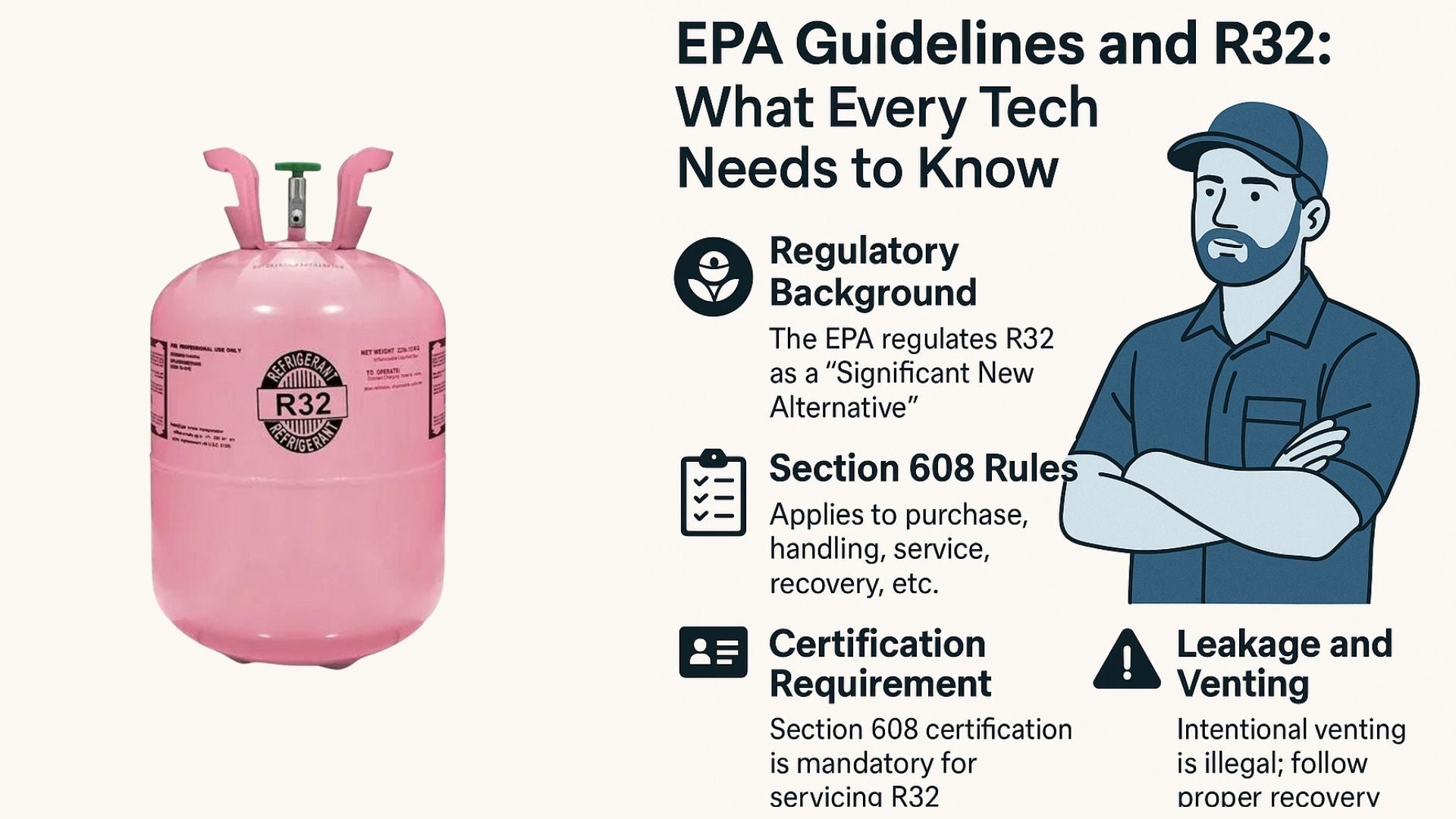👋 Why This Matters
Let’s be honest — most of us don’t get into HVAC for the paperwork. But with refrigerants like R32, the EPA’s rules matter more than ever. If you're installing, servicing, or even transporting these units, you need to be on the right side of Section 608 of the Clean Air Act, not just for compliance, but to protect your license and your clients.
This is your no-fluff, technician-first guide to EPA guidelines for R32 — what matters, what’s changing, and how to stay sharp.
📜 1. EPA Section 608: The Rule That Covers It All
Section 608 is the part of the Clean Air Act that governs refrigerants. Here’s what it requires:
-
Certification: Anyone handling refrigerants (charging, recovering, servicing) must be EPA 608 certified.
-
Leak Management: You must fix refrigerant leaks on systems with large charges (over 50 lbs) within 30 days.
-
Proper Recovery: Venting refrigerants is illegal — use certified recovery equipment.
👉 R32 is subject to Section 608, just like R410A. That means you need to follow the same recovery and handling procedures — no shortcuts.
⚠️ 2. R32’s “Mild Flammability” — What It Means for Techs
R32 is rated A2L: non-toxic, mildly flammable. Here’s what that means practically:
| Property | R410A | R32 |
|---|---|---|
| Flammability | A1 (non-flammable) | A2L (mildly flammable) |
| Toxicity | A (non-toxic) | A (non-toxic) |
Do you need special PPE?
Not really. Just stick to your standard gear: gloves, goggles, and proper ventilation.
Do you need to be scared of A2L?
No. In PTAC units, the R32 charge is small, sealed, and housed with built-in safety measures. Just don’t go cutting open coils with a torch.
🛠️ 3. Labeling and Handling: What the EPA Expects
When working with R32 systems:
-
Labeling: Units must display the refrigerant type, charge amount, and flammability warning.
-
Transport: Use DOT-approved cylinders for R32. Make sure cylinders are color-coded (light blue) and properly sealed.
-
Storage: Store R32 tanks upright, in well-ventilated areas, and out of direct sunlight.
👉 Pro Tip: Many of the new R32 PTACs from The Furnace Outlet come pre-charged and sealed, which makes life a lot easier — and safer — on the job site.
📅 4. The HFC Phasedown Is Happening — Here’s the Timeline
The American Innovation and Manufacturing (AIM) Act mandates a gradual phase-down of HFCs, including R410A. Here’s how it affects you:
-
2024: 40% reduction in HFC production baseline
-
2029: 70% reduction
-
2036: 85% reduction
That’s why more manufacturers are switching to R32 now — it's lower-GWP, available, and future-compliant.
🔑 5. What You Need to Do
As a tech or contractor, your to-do list looks like this:
✅ Get your EPA 608 Certification (Type I or Universal)
✅ Understand and follow A2L safety procedures
✅ Use proper recovery equipment and techniques
✅ Stay informed — refrigerant rules are evolving fast
✅ Recommend R32 PTACs as a future-ready solution
🔁 Wrapping It Up
Look, I’ve been around long enough to know when the HVAC world is shifting. R32 is the new normal, and understanding the EPA’s expectations is part of being a good tech today. Stay safe, stay certified, and work smart.
Check out our full R32 PTAC collection — all models are fully EPA-compliant and designed for smooth installs.







